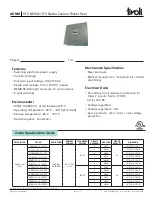
QRP-20
•
13
5. Insert and solder R1, the 10K tuning potentiometer.
6. Insert and solder S1, pushbutton switch.
Carefully select, insert and solder the following components in the order given
in the following steps. Check off each step as completed.
7. C16, 100 to 220 uf electrolytic. Electrolytic capacitors are polarized,
which means there is a right and a wrong way to install them! Generally,
the Negative ( - ) side is indicated on the capacitor, while the Positive ( + )
is shown on the PC board. Make sure that the capacitor is inserted
correctly into the PC board with the ( + ) lead into the ( + ) hole and the ( - )
lead into the ( - ) hole.
8. R11, 100 ohm [brown-black-brown].
9. C19, .01 uf (marked .01 or 103 or 10 nf).
10. D2, 1N4148 diode. This diode is the small glass bead type, do not
confuse with D1, the 1N4002, which is larger in size. For correct polarity,
the dark band must face as shown on the parts layout diagram.
11. C10, .01 uf (marked .01 or 103 or 10 nf).
The preceding parts comprise much of the circuitry which blocks RF from the
receiver during transmission and permits the antenna to be connected to the
receiver jack during "key-up" conditions. To further complete this section of the
circuit, we now install the first of three 100 uh RF chokes. They look like a
resistor with brown-black-brown-silver (or gold) bands. In the following steps,
be sure to save the clipped-off component lead wires from R12 and R13. These
will be used for "jumpers" in later steps.
12. Install L5, 100 uh inductor [brown-black-brown-silver].
13. Install R12, 1K resistor [brown-black-red].
14. Install R13, 1K resistor [brown-black-red].
15. Using a scrap component lead wire, install JMP1. Jumper wires simply
connect two PC board traces together, jumping over other traces!
Next study the orientation of Q4, the keying transistor. Be careful in identifying
Q4; it is the only PNP device, and its part number or case style may vary
slightly. If necessary, positively identify Q1, the 2N3904 oscillator transistor,
and set it aside, since Q4 is similar or identical in style. Proceed with the
following steps, in order, once you are positive you have selected Q4 as the
221-334 PNP transistor.
16. Install R15, 10K ohms [brown-black-orange].
17. Install C13, .01 uf (marked .01 or 103 or 10 nf).
Summary of Contents for QRP20
Page 10: ...QRP 20 10...
Page 11: ...QRP 20 11 QRP20 PARTS LAYOUT DIAGRAM...
Page 22: ...QRP 20 22...










































